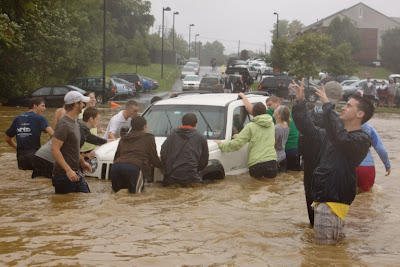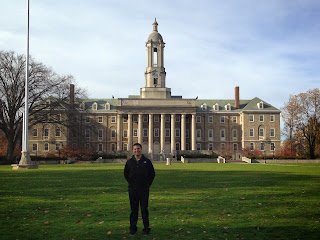Crisis Management 101
It is kind of hard to believe that
it has been a year since Hurricane Irene hit landfall last summer. For many
people, Hurricane Irene was just another terrible storm, affecting some more
than others. Hurricane Irene hit Marist pretty badly- power was lost to many
buildings, areas were closed off to students due to severe flooding, and
infrastructure was heavily damaged because of all of the water.
 |
| Marist students rescue a car from a flooded parking lot during Hurricane Irene |
The day after Hurricane Irene ended,
I received an intense crash course in crisis management that I will never
forget. I woke up to a phone call at 7:00 in the morning, and it was an unknown
number. I answered it, and it was the President of the college, Dr. Dennis Murray,
asking me if I could come to a makeshift command center in the student center as
soon as possible for an emergency meeting. About a half hour later, I got to
the student center, and the entire senior administration alongside the student
affairs staff was there. Our first task was establishing a direct line of
communication with students, parents and staff.
It never
seeks to amaze me how important social media can be in communication during a
crisis. I was fortunate enough to be sitting next to Tim Massie, then Chief
Public Affairs Officer of Marist, who is a twitter master and knows the ins and
outs of how to use social media in just about any situation. Tim says that, “during
a crisis, social media is invaluable in keeping people informed and squelching
rumors.” During the meeting, we had a twitter page up on a screen displaying
the most up to date tweets with the #Marist hashtag. Every time someone would
post something that was fabricated or exaggerated, we would confirm that the tweet
was a rumor, than squash that tweet using social media. (I strongly
recommend reading Tim’s perspective of the Hurricane Irene ordeal, which can be
found on his blog here.)
After
President Murray gave everyone their tasks for the day, he asked me to go with
him to visit the affected areas. We jumped into his car, drove and walked
around to the worst hit areas of campus, assessing the damage first hand. After
a few hours “in the field,” we reconvened with the entire group. Late in the
afternoon at this point, each administrator had a POA (Plan of Attack) for what
the next steps were going to be for getting Marist back to normal. It was great
seeing how so many different departments came together to make the best out of
a potential terrible situation, and it reminded me once again just how great the leadership
team at Marist is.
 |
| A clip of the memorandum from Marist President Dr. Murray |
The
following day, Dr. Murray sent out a memorandum to the college community, which
can be found in full here. As one Vice President told me early that morning, “you
are going to learn more today than you will in an entire semester of college.” And
he couldn’t have hit the nail on the head any better.


Comments
Post a Comment